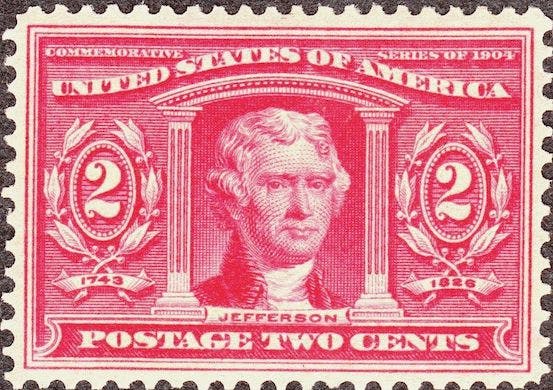Delving Into the Many Layers of Jeffersonian Vision
Both Gutzman and Kaplan show that America could not do without Jefferson’s inspiring rhetoric — even if the facts on the ground often made his pronouncements absurd.

‘The Jeffersonians: The Visionary Presidencies of Jefferson, Madison, and Monroe’
By Kevin R.C. Gutzman
St. Martin’s Press, 608 pages
‘His Masterly Pen: A Biography of Jefferson the Writer’
By Fred Kaplan
Harper, 672 pages
Nowhere in “Visionary Presidencies” does Kevin R.C. Gutzman actually define the Jeffersonian vision. In fact, it is rather easy to get lost in the welter of this detailed political history. If you read to the end of the book, something like a vision emerges that, in important matters, actually departs from Jefferson’s own idea of the presidency.
Jefferson is famous for his faith in limited government. He opposed a standing army, thought the Supreme Court under Chief Justice John Marshall had usurped congressional and presidential power, and decried the Hamiltonian/Federalist conception of a strong central government and banking system.
As president, Jefferson did not always adhere to Republican principles, as Mr. Gutzman, following the lead of other historians, demonstrates. Was the Louisiana Purchase constitutional? Jefferson would rather not say, preferring to acquire the vast new land holdings and argue about the right to do so later.
Mr. Gutzman explains how James Madison, emulating his illustrious predecessor and Virginian ally by refusing to adequately prepare for the country’s defense, made a mess of the War of 1812, worsened by his appointment of incompetents to his Cabinet.
James Monroe carried on the Jeffersonian tradition of perpetuating the fiction that the nation needed only one political party — his own. President Monroe did his best to bring on board disaffected Federalists, even while relying on a banking infrastructure and military preparedness that became, in effect, a vindication of Hamiltonian principles.
What is missing from Mr. Gutzman’s sprawling history is a hard look at the purblind Jeffersonian vision. Fred Kaplan’s book remedies that lack of biographical insight.
Mr. Kaplan relentlessly explores the fictions and evasions Jefferson perpetuated in his writing. Like his two slave-holding successors, he deplored on paper what became known as the “peculiar institution.” He set the pattern perpetuated by Madison and Monroe — listening to but not heeding Lafayette’s lectures about the hypocrisy and cruelty of owning human beings.
Jefferson-Madison-Monroe concluded, after tentative efforts to advocate abolition, that the South was not prepared to free its Black chattel. A day did not go by when these statesmen did not have the help of house and field slaves. The Jeffersonians projected an end to slavery into the distant future — when the emancipated would be sent to Liberia.
Mr. Gutzman notes that President Monroe also wanted Native Americans shipped somewhere out of sight, to lands where whites had not settled. In fact, he wanted to rid the nation of the idea that Native Americans had a sovereign right to any land.
Monroe hoped that Native Americans would peaceably agree with Jeffersonian paternalism, handed down from the Great White Father, as Jefferson dubbed himself in a species of Indian talk that Mr. Kaplan describes with acute perception.
Absent from Mr. Gutzman’s political narrative is how deluded Jefferson could be, presuming agrarian life to be superior to city life and that the Hamiltonian urban vision was not merely wrong, but perfidious and practically traitorous to the very idea of America.
Both Mr. Gutzman and Mr. Kaplan show that America could not do without Jefferson’s inspiring rhetoric — even if the facts on the ground often made his pronouncements absurd, such as his saying that the common man in America had it much better off economically than his European counterparts. Mr. Kaplan shows that, in the main, this was just not so.
The Jeffersonian vision, as I read Mr. Gutzman, attenuated, though the historian does not put it so baldly. By the time Monroe went on his country tour of unity, the Jeffersonians had long ago triumphed over the Federalists, and the president himself, as Mr. Gutzman’s narrative shows, had become self-congratulatory.
At best, Monroe consolidated in the Monroe Doctrine a Jeffersonian vision of the Americas that resisted the encroachments of European powers and the efforts of Spain to reconstitute colonies in South America.
For the ramifications of the Jeffersonian temperament, Mr. Kaplan is your go-to man. Mr. Kutzman, on the other hand, shows that the Jeffersonian vision remains a powerful check on centralizing tendencies that Jefferson feared could transform into tyranny.
Mr. Rollyson is the author of “American Biography” and is at work on “Making the American Presidency: How Biographers Shape History.”

